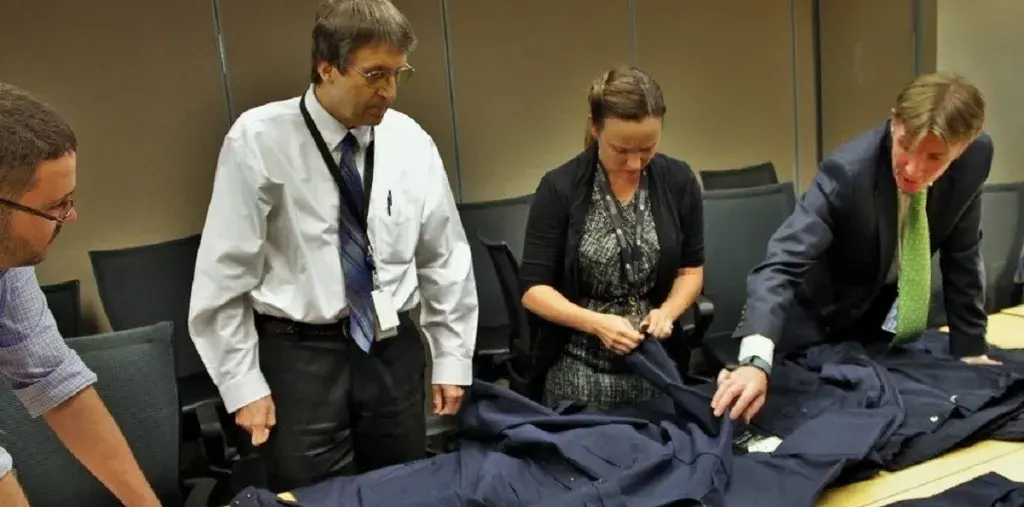The Department of Homeland Security (DHS) Science and Technology Directorate (S&T) and the First Responder Technologies Division (R-Tech) are working to develop new protective clothing for first responders.
 The goal of the Base Ensemble Project is to develop an improved duty uniform designed to provide first responders with better protection from the many hazards they encounter in their daily duties. In partnership with the project performers and the United Kingdom’s Home Office, S&T is testing different prototypes and garment materials to produce a final product. Emergency first responders often encounter unpredictable and dangerous environments when responding to calls. Blood, chemicals and debris are just a few of the many types of hazards a firefighter or law enforcement officer might be exposed to when answering a call. For example, first responders may encounter broken glass at the scene of a car accident or risk exposure to chemicals upon venturing into an enclosed space that housed a meth lab.
The goal of the Base Ensemble Project is to develop an improved duty uniform designed to provide first responders with better protection from the many hazards they encounter in their daily duties. In partnership with the project performers and the United Kingdom’s Home Office, S&T is testing different prototypes and garment materials to produce a final product. Emergency first responders often encounter unpredictable and dangerous environments when responding to calls. Blood, chemicals and debris are just a few of the many types of hazards a firefighter or law enforcement officer might be exposed to when answering a call. For example, first responders may encounter broken glass at the scene of a car accident or risk exposure to chemicals upon venturing into an enclosed space that housed a meth lab.
Input and feedback from first responders played a crucial part during the project’s design phase. The First Responder Resource Group (FRRG) helped provide a conduit for that input. The FRRG is an all-volunteer working group and helps S&T focus on how new technologies under development meet the needs of responders in the field. FRRG members frequently will provide input on multiple related topics and then can see impacts across the HSE. For instance, Steve Vandewalle, a firefighter and paramedic from the San Diego Fire Department who also participated in field tests for the Improved Structure Firefighting Glove, was one FRRG member who contributed to this base ensemble prototype design.
“The traditional roles of fire, law enforcement, and EMS continue to cross over into each other’s' disciplines. With the ‘All Hazards Preparedness’ mandates, we must all have a working knowledge of each other's roles, responsibilities, and hazards,” Vandewalle explained. “The base ensemble project is an attempt to provide an increased level of protection from a variety of cross-discipline hazards—if our roles continue to expand, our personal protective equipment must match the hazards.”
Through the Base Ensemble Project, improvements to the standard design of first responder uniforms may include greater reinforced materials in a pair of pants’ knees and resistance to liquids such as gasoline or blood. As first responders’ uniforms can suffer significant wear and tear, reinforcing key areas, such as the knees, or offering resistance to potentially dangerous substances can provide responders with an extra level of protection while fulfilling their duties.
In the summer of 2015, R-Tech conducted a focus group workshop with S&T’s partners from the U.K. Home Office. They inspected and examined the initial prototype base ensemble garment produced by the project’s developers with the help of first responders from FRRG. This initial prototype garment incorporated limited protection against likely unanticipated hazards such as splash resistance for fluid/chemical protection, antimicrobial surfaces, rip/tear protection, and flame resistance. The prototype uniform design will be modified based upon the first responder feedback to enhance fit and comfort. Once the prototype designs are complete, the project developer will deliver 150 prototypes to R-Tech and the U.K. Home Office for extensive capabilities and comfort testing before submittal for NFPA 1975 certification.
For more information on the Base Ensemble Project, contact first.responder@hq.dhs.gov.
